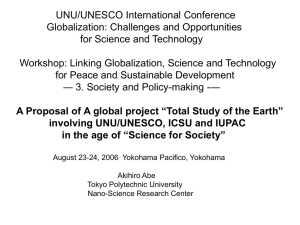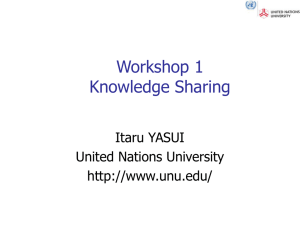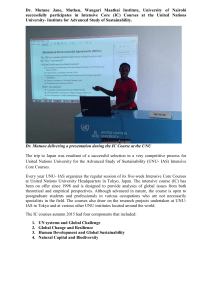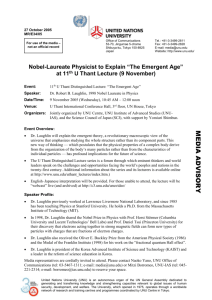AJIT K MOHANTY JAWAHARLAL NEHRU UNIVERSITY
advertisement
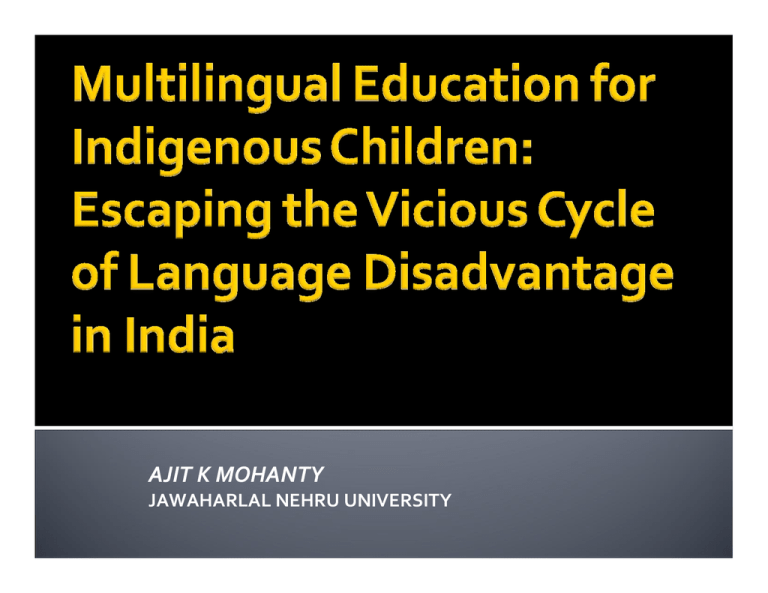
AJIT K MOHANTY JAWAHARLAL NEHRU UNIVERSITY POVERTY AS CAPABILITY DEPRIVATION INDIAN MULTILINGUALISM & THE CYCLE OF DISADVANTAGE LANGUAGES IN INDIAN EDUCATION TRIBES IN INDIA: LANGUAGE, EDUCATION & POVERTY MULTILINGUAL EDUCATION FOR THE TRIBAL CHILDREN: STATUS, INITIATIVES & PROSPECTS SOME CONCLUDING OBSERVATIONS UNESCO‐UNU Conf.Tokyo Aug.27‐28,08 2 Capability = Range of Options & Choices Social discrimination → lack of opportunities → lack of freedom → capability deprivation → poverty Enabling role of education for economic development The problem of ‘voicelessness’ & language disadvantage with educational barriers for the Tribes (indigenous peoples) in India UNESCO‐UNU Conference, Tokyo Aug.27‐28,08 3 3372 MOTHER TONGUES (1576 listed, 1796 as ‘other’ languages) 300 – 400 LANGUAGES 22+1 OFFICIAL LANGUAGES 87 LANGUAGES OF PRINT MEDIA 104 FOR RADIO BROADCASTING 81/41 IN PRIMARY EDUCATION (1970/98) MINORITY LINGUISTIC GROUPS>20% in half of the Districts Relationship between Language, Power & Hierarchy: “Multilingualism of the Unequals” (Mohanty,2004) 4 INDIGENOUS/MINORITY LANGUAGES JUSTIFICATION OF EDUCATIONAL FURTHER & NEGLECT THE VICIOUS CYCLE SOCIAL NEGLECT WEAKENING OF LANGUAGES UNESCO‐UNU Conference, Tokyo Aug.27‐28,08 5 90 80 70 Language media 60 50 40 30 20 10 0 1970 1976 1978 1990 1998 UNESCO‐UNU Conference, Tokyo Aug.27‐28,08 Declining number of languages/media in schools MT education for tribal (indigenous) children < 1% English Medium schools ‐ Indian Language(s) taught as subject(s) Regional language medium schools – English as compulsory second language by grade 4 Hindi NOT taught as a compulsory subject in most states or taught as a third language from grade 5 6 Illiteracy & relapse to illiteracy Poor educational performance Subtractive language learning in forced submersion programs ¾ High ‘push‐out’ rate ¾ Capability deprivation & Poverty ¾ Loss of diversity ¾ ¾ ¾ UNESCO‐UNU Conference, Tokyo Aug.27‐28,08 7 Tribal population: 84.3 million(8.2%) [ST:16.23%] 623 Tribal Communities (ASI); 573 notified or Scheduled Tribes 218 languages (159 excusive to the tribes) Most tribal language do not have a script; written in major regional language scripts Wide spread adult bilingualism (500 of 623 communities classified as bilingual) UNESCO‐UNU Conference, Tokyo Aug.27‐28,08 8 13 tribal languages used in various programs (12 in NE States only) Only 3 to 4 used as MI in regular school programs Less than 1% STs have scope for MT medium schooling UNESCO‐UNU Conference, Tokyo Aug.27‐28,08 9 High proportion of STs in Primary Schools (Grades I to V) 58,343 schools – above 90% 76,458 schools – above 75% 103,609 schools – above 50% Tribal children taught in forced submersion programs in L2 (majority language) medium UNESCO‐UNU Conference, Tokyo Aug.27‐28,08 10 The burden of non‐comprehension (Mohanty, 1999, In press; Jhingran, 2005 etc) Low literacy, high push out rates (Table 1) Poor Classroom Achievement (see Table 2) Higher rate of school failure & low achievement level (see Table 3) Low enrolment in higher & technical education (see Table 4) UNESCO‐UNU Conference, Tokyo Aug.27‐28,08 11 Gross Enrolment Ratio and Drop Out Rate 120 ST SC Total Population 100 Percentage 80 60 40 20 0 CLASS I-V (6-11 CLASS VI-VIII (11- CLASS I-VIII (6-14 YEARS) 14 YEARS) YEARS) UNESCO‐UNU Conference, Tokyo Aug.27‐28,08 CLASS I-V CLASS I-VIII CLASS I-X 12 High School Performance of SC, ST & Others 70.00% 60.00% Percentage 50.00% Fail (<30%) 3rd Division (30-44%) 2nd Division (45-59%) 1st Division (>60%) 40.00% 30.00% 20.00% 10.00% 0.00% SC ST Others UNESCO‐UNU Conference, Tokyo Aug.27‐28,08 SC ST Others SC ST others 13 Limited chance for upward socio‐economic mobility Low quality employment which does not require formal education/training Only 4% of STs are regular workers 31.1% are marginal workers (<6 months a year) [SCs 27%, Others 19.8%] Capability Deprivation & Poverty UNESCO‐UNU Conference, Tokyo Aug.27‐28,08 14 Proportion of population below the poverty line: STs:44%; SCs:36%; Others:16% Decline in the percentage below the poverty line between 1993‐94 and 1999‐2000: 7% STs 12% SCs 9% other categories approximately 50% of the ST households in rural areas belong to the consumption class of less than 340 Indian Rupees (approximately $7.80). The corresponding figures for the SCs, other backward castes (OBC) and others are 40%, 30% and 17%, respectively. The picture of economic development is even more dismal for the STs outside the North Eastern States in India. UNESCO‐UNU Conference, Tokyo Aug.27‐28,08 15 Children do not learn (capability deprivation, poverty) y Loss of Identity y Weakening of languages (the vicious cycle of disadvantage) y Subtractive language learning (Loss of MT) y Loss of linguistic diversity – Language Death, Murder, Genocide. (Suicide?) y Marginalization, domain shrinkage y Unimplemented (passive) state policies, statutes (Mohanty, Panda, Phillipson & Skutnabb‐Kangas, 2009) y UNESCO‐UNU Conference, Tokyo Aug.27‐28,08 16 Tribal children in MT medium schools perform better than those in L2 medium schools (Saikia & Mohanty,2004; Sema, 2008) Other Indian studies also show better performance in MT medium schools when SES differences are controlled (Nayak, 2007; Patra, 1998 etc) UNESCO‐UNU Conference, Tokyo Aug.27‐28,08 17 Mother Tongue + Languages for regional & national communication + LWC MT → Regional Language → National Language → English Meaningful participation in the wider democratic, socio‐political, economic system Empowerment UNESCO‐UNU Conference, Tokyo Aug.27‐28,08 18 UNESCO‐UNU Conference, Tokyo Aug.27‐28,08 19 Multilingual Education for the Linguistic Minorities UNESCO‐UNU Conference, Tokyo Aug.27‐28,08 Effective Instruction in MT Medium (at least for 5‐8 years) ↓ MT + L2 (both as MI) ↓ L3 (& other languages) ↓ High Multilingual Proficiency 20 MLE: 10 languages; 195 schools; April 2007 (first MLE + MLE + UNESCO‐UNU Conference, Tokyo Aug.27‐28,08 batch in Grade II) MLE+: 2 Languages (Saora & Kui) 8 schools from the MLE program 21 MLE PROGRAM IN ORISSA Curriculum & material development in Tribal languages with cultural content Tribal MT (L1)as Language of Instruction (MI) L2 (Oriya) conversational fluency development L2 as partial MI from Grade III, 100% from Grade V (Hindi and English as language subjects) Teachers from among Tribal community, multilingual with Tribal MT, Oriya and at least communicative Hindi & some knowledge of English 22 Y G O L O N H IO C T Y & N S h E P t V a L R A E M , T R e U g IN l T a s e L u v lu U g e P l n C l E a : y t a L L K i c : n ori R ) M s u a O o re m ist ty r W c i E m A i H o r M v l M i a C a t A o & cul Sc. & r c R u A i t F acr h l l r c r u a a t u C ( o n C M r ( e l T p a m A p c Fo viron m A : CH s o n n o E ssr o i t n a l e C erv nt UNESCO‐UNU Conference, i Tokyo Aug.27‐28,08 23 ) y or Strategies: MLE Plus Intervention 9Ethnographic Survey: Documenting Cultural Practices 9Developing Innovative Activities based on Cultural Practices for Teaching 9Reading corner in the Classroom 9Synergistic ‘Read Together’ Program for the Community 24 9Books with Community Authorship Class Subject MLE+ Schools (N=74) MLE Schools (N=47) NON‐MT Schools (N=45) Language 55.36 36.59 37.40 Math 58.29 38.95 40.62 EVS 65.10 54.62 47.20 Note: Higher attendance rate for MLE Plus Children UNESCO‐UNU Conference, Tokyo Aug.27‐28,08 25 Experimental MLE programs more effective than traditional submersion programs; Expansion into new states Lack of methodological groundings & systematic evaluation Gap between theory & practice (Early‐exit models instead of more successful late‐exit models) Absence of Policy & Material Support; Lack of long term Government Commitment UNESCO‐UNU Conference, Tokyo Aug.27‐28,08 26 UNESCO‐UNU Conference, Tokyo Aug.27‐28,08 27

